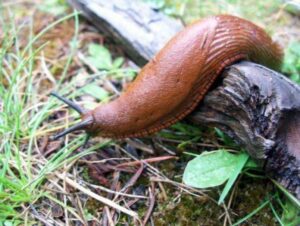12 Easy Tips for Getting Rid of Slugs in your Garden

There’s nothing like seeing your garden taken over by slugs. Not only can slugs munch through all your seedlings in minutes, but they can also destroy your favorite hosta or delphinium in days.
The slug is a hermaphrodite, which means they have both male and female reproductive systems and can mate with themselves. Each slug can produce up to 36 eggs, several times a year. They reach adulthood in about six weeks and some species have a life span of 2-6 years. To top it off slugs keep growing. There are some that reach 10 inches. Imagine meeting one of those on a summer’s eve.
They have an insatiable appetite and feed mainly at night and can eat double its body weight in a day. I don’t know who took the time to count, but I read they have 27,000 teeth. Could this be?
Slugs are one of the most destructive and difficult pests to control but they do play an important role in ecology by eating decomposing matter.
They love dark, moist spots. With this in mind the first approach is to eliminate habitats by cleaning and hoeing your garden regularly as slugs and eggs hide under the weeds. It is important to remove all vegetable refuse, as well as bricks, boards and piles of debris they can hide under.
Throw slugs that you have collected dead or alive and put in the compost. The live ones stay put and help break down the compost. It just proves that there is good in everything. The dead ones are full of protein and will add to the compost.
Plants that are resistant to slugs include Phlox, Campanula, Hererocallis, and Mentha.
Here are some solutions:
1. Slugs avoid crawling over anything dry, dusty or scratchy, such as lime, diatomaceous earth, cinders, coarse sawdust, gravel or sand. These make great barriers to keep out slugs.
2. Epson Salts sprinkled on the soil will help deter slugs and also help prevent Magnesium deficiency in your plants.
3. Vinegar, a good ingredient for slug sprays and removing slug slime.
4. Spread salt around your plants. Salt dries them out so they won’t go near it.
5. Collect human, dog, or cat hair and put around your plants, not only will the slugs not go on it, but it will also keep a lot of the little critters away also.
6. When you find a slime trail, destroy the track so other slugs do not follow. They will follow each others trail. There are certain plants that slugs hate like the strong smell of mint, chives, garlic, geraniums, foxgloves and fennel. Plant them around the edge of your garden to keep them out. These plants also discourage Japanese beetles.
7. Put stone paths along your flower beds.
8. Put Copper of foil barriers around plants that the slugs are eating. When the slugs cross them they are given a small shock. This also works for snails.
9. If you are find slugs in your potted plants, put petroleum jelly around the base and tops of your plant containers and watch them slip and slide.
10. Fill a shallow bowl with beer and wait overnight. The slugs love it. Dispose of the slugged brew by adding it to your comport.
11. Another slug formula: 1 part ammonia to 3 parts of water. One squirt on the slugs is all you need.

12. After eating your 1/2 grapefruit for breakfast, put it into your garden to make slug trap. Turn upside down after putting a small hole or two on the side for slugs to enter. They adore grapefruit and the slugs will gather there to eat the grapefruit and leave your plants alone. Collect the grapefruit and put into the compost bin.
If anyone has a system that works, let this author know.
Related on Organic Authority
8 Steps to Garden Pest Control Without the Chemicals
15 Fantastic Green Gardening Ideas and Hacks
Benefits of Rasing Chickens: Organic Weed and Pest Control
Barbara Chick is a Certified Master Gardener and Master Composter.
Visit http://www.myorganicflowers.com and subscribe
to free newsletter or Blog for more tips and information.


